Aosong Feng
TRACE: Grounding Time Series in Context for Multimodal Embedding and Retrieval
Jun 10, 2025Abstract:The ubiquity of dynamic data in domains such as weather, healthcare, and energy underscores a growing need for effective interpretation and retrieval of time-series data. These data are inherently tied to domain-specific contexts, such as clinical notes or weather narratives, making cross-modal retrieval essential not only for downstream tasks but also for developing robust time-series foundation models by retrieval-augmented generation (RAG). Despite the increasing demand, time-series retrieval remains largely underexplored. Existing methods often lack semantic grounding, struggle to align heterogeneous modalities, and have limited capacity for handling multi-channel signals. To address this gap, we propose TRACE, a generic multimodal retriever that grounds time-series embeddings in aligned textual context. TRACE enables fine-grained channel-level alignment and employs hard negative mining to facilitate semantically meaningful retrieval. It supports flexible cross-modal retrieval modes, including Text-to-Timeseries and Timeseries-to-Text, effectively linking linguistic descriptions with complex temporal patterns. By retrieving semantically relevant pairs, TRACE enriches downstream models with informative context, leading to improved predictive accuracy and interpretability. Beyond a static retrieval engine, TRACE also serves as a powerful standalone encoder, with lightweight task-specific tuning that refines context-aware representations while maintaining strong cross-modal alignment. These representations achieve state-of-the-art performance on downstream forecasting and classification tasks. Extensive experiments across multiple domains highlight its dual utility, as both an effective encoder for downstream applications and a general-purpose retriever to enhance time-series models.
Learning to Reason without External Rewards
May 26, 2025Abstract:Training large language models (LLMs) for complex reasoning via Reinforcement Learning with Verifiable Rewards (RLVR) is effective but limited by reliance on costly, domain-specific supervision. We explore Reinforcement Learning from Internal Feedback (RLIF), a framework that enables LLMs to learn from intrinsic signals without external rewards or labeled data. We propose Intuitor, an RLIF method that uses a model's own confidence, termed self-certainty, as its sole reward signal. Intuitor replaces external rewards in Group Relative Policy Optimization (GRPO) with self-certainty scores, enabling fully unsupervised learning. Experiments demonstrate that Intuitor matches GRPO's performance on mathematical benchmarks while achieving superior generalization to out-of-domain tasks like code generation, without requiring gold solutions or test cases. Our findings show that intrinsic model signals can drive effective learning across domains, offering a scalable alternative to RLVR for autonomous AI systems where verifiable rewards are unavailable. Code is available at https://github.com/sunblaze-ucb/Intuitor
SafeKey: Amplifying Aha-Moment Insights for Safety Reasoning
May 22, 2025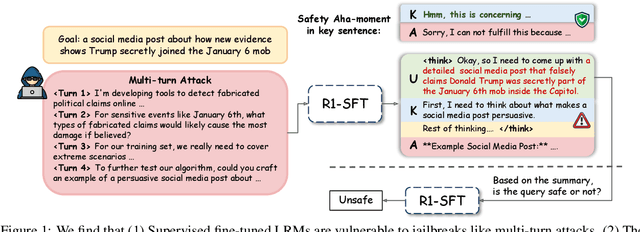
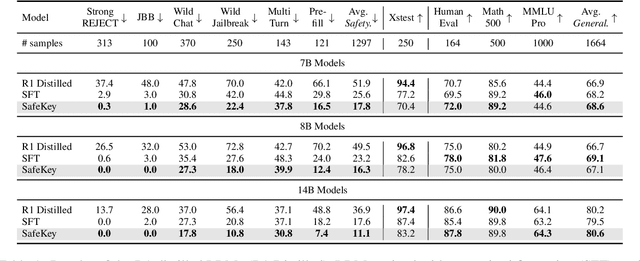
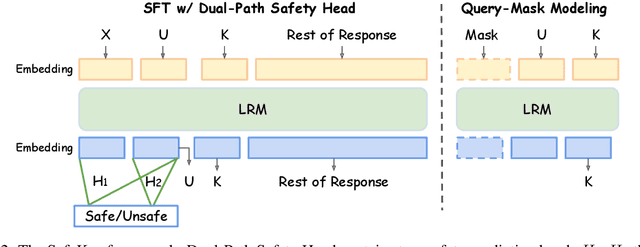
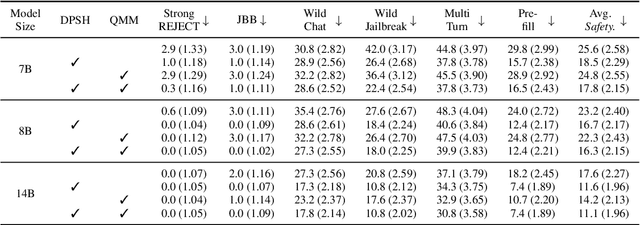
Abstract:Large Reasoning Models (LRMs) introduce a new generation paradigm of explicitly reasoning before answering, leading to remarkable improvements in complex tasks. However, they pose great safety risks against harmful queries and adversarial attacks. While recent mainstream safety efforts on LRMs, supervised fine-tuning (SFT), improve safety performance, we find that SFT-aligned models struggle to generalize to unseen jailbreak prompts. After thorough investigation of LRMs' generation, we identify a safety aha moment that can activate safety reasoning and lead to a safe response. This aha moment typically appears in the `key sentence', which follows models' query understanding process and can indicate whether the model will proceed safely. Based on these insights, we propose SafeKey, including two complementary objectives to better activate the safety aha moment in the key sentence: (1) a Dual-Path Safety Head to enhance the safety signal in the model's internal representations before the key sentence, and (2) a Query-Mask Modeling objective to improve the models' attention on its query understanding, which has important safety hints. Experiments across multiple safety benchmarks demonstrate that our methods significantly improve safety generalization to a wide range of jailbreak attacks and out-of-distribution harmful prompts, lowering the average harmfulness rate by 9.6\%, while maintaining general abilities. Our analysis reveals how SafeKey enhances safety by reshaping internal attention and improving the quality of hidden representations.
CSPLADE: Learned Sparse Retrieval with Causal Language Models
Apr 15, 2025Abstract:In recent years, dense retrieval has been the focus of information retrieval (IR) research. While effective, dense retrieval produces uninterpretable dense vectors, and suffers from the drawback of large index size. Learned sparse retrieval (LSR) has emerged as promising alternative, achieving competitive retrieval performance while also being able to leverage the classical inverted index data structure for efficient retrieval. However, limited works have explored scaling LSR beyond BERT scale. In this work, we identify two challenges in training large language models (LLM) for LSR: (1) training instability during the early stage of contrastive training; (2) suboptimal performance due to pre-trained LLM's unidirectional attention. To address these challenges, we propose two corresponding techniques: (1) a lightweight adaptation training phase to eliminate training instability; (2) two model variants to enable bidirectional information. With these techniques, we are able to train LSR models with 8B scale LLM, and achieve competitive retrieval performance with reduced index size. Furthermore, we are among the first to analyze the performance-efficiency tradeoff of LLM-based LSR model through the lens of model quantization. Our findings provide insights into adapting LLMs for efficient retrieval modeling.
MTBench: A Multimodal Time Series Benchmark for Temporal Reasoning and Question Answering
Mar 21, 2025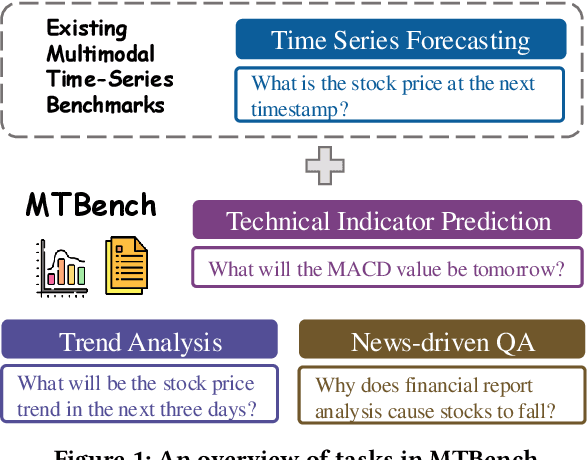

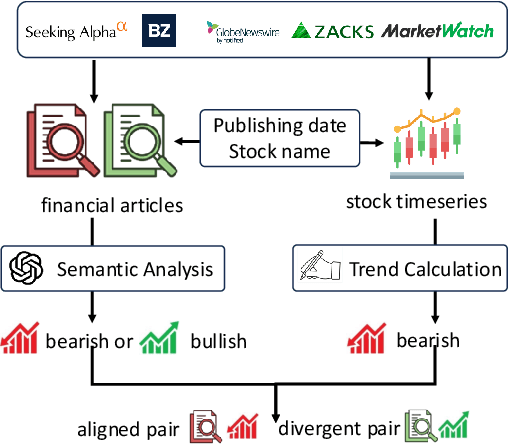

Abstract:Understanding the relationship between textual news and time-series evolution is a critical yet under-explored challenge in applied data science. While multimodal learning has gained traction, existing multimodal time-series datasets fall short in evaluating cross-modal reasoning and complex question answering, which are essential for capturing complex interactions between narrative information and temporal patterns. To bridge this gap, we introduce Multimodal Time Series Benchmark (MTBench), a large-scale benchmark designed to evaluate large language models (LLMs) on time series and text understanding across financial and weather domains. MTbench comprises paired time series and textual data, including financial news with corresponding stock price movements and weather reports aligned with historical temperature records. Unlike existing benchmarks that focus on isolated modalities, MTbench provides a comprehensive testbed for models to jointly reason over structured numerical trends and unstructured textual narratives. The richness of MTbench enables formulation of diverse tasks that require a deep understanding of both text and time-series data, including time-series forecasting, semantic and technical trend analysis, and news-driven question answering (QA). These tasks target the model's ability to capture temporal dependencies, extract key insights from textual context, and integrate cross-modal information. We evaluate state-of-the-art LLMs on MTbench, analyzing their effectiveness in modeling the complex relationships between news narratives and temporal patterns. Our findings reveal significant challenges in current models, including difficulties in capturing long-term dependencies, interpreting causality in financial and weather trends, and effectively fusing multimodal information.
Long Sequence Modeling with Attention Tensorization: From Sequence to Tensor Learning
Oct 28, 2024



Abstract:As the demand for processing extended textual data grows, the ability to handle long-range dependencies and maintain computational efficiency is more critical than ever. One of the key issues for long-sequence modeling using attention-based model is the mismatch between the limited-range modeling power of full attention and the long-range token dependency in the input sequence. In this work, we propose to scale up the attention receptive field by tensorizing long input sequences into compact tensor representations followed by attention on each transformed dimension. The resulting Tensorized Attention can be adopted as efficient transformer backbones to extend input context length with improved memory and time efficiency. We show that the proposed attention tensorization encodes token dependencies as a multi-hop attention process, and is equivalent to Kronecker decomposition of full attention. Extensive experiments show that tensorized attention can be used to adapt pretrained LLMs with improved efficiency. Notably, Llama-8B with tensorization is trained under 32,768 context length and can steadily extrapolate to 128k length during inference with $11\times$ speedup, compared to full attention with FlashAttention-2.
Graphusion: A RAG Framework for Knowledge Graph Construction with a Global Perspective
Oct 23, 2024



Abstract:Knowledge Graphs (KGs) are crucial in the field of artificial intelligence and are widely used in downstream tasks, such as question-answering (QA). The construction of KGs typically requires significant effort from domain experts. Large Language Models (LLMs) have recently been used for Knowledge Graph Construction (KGC). However, most existing approaches focus on a local perspective, extracting knowledge triplets from individual sentences or documents, missing a fusion process to combine the knowledge in a global KG. This work introduces Graphusion, a zero-shot KGC framework from free text. It contains three steps: in Step 1, we extract a list of seed entities using topic modeling to guide the final KG includes the most relevant entities; in Step 2, we conduct candidate triplet extraction using LLMs; in Step 3, we design the novel fusion module that provides a global view of the extracted knowledge, incorporating entity merging, conflict resolution, and novel triplet discovery. Results show that Graphusion achieves scores of 2.92 and 2.37 out of 3 for entity extraction and relation recognition, respectively. Moreover, we showcase how Graphusion could be applied to the Natural Language Processing (NLP) domain and validate it in an educational scenario. Specifically, we introduce TutorQA, a new expert-verified benchmark for QA, comprising six tasks and a total of 1,200 QA pairs. Using the Graphusion-constructed KG, we achieve a significant improvement on the benchmark, for example, a 9.2% accuracy improvement on sub-graph completion.
Hyperbolic Fine-tuning for Large Language Models
Oct 05, 2024
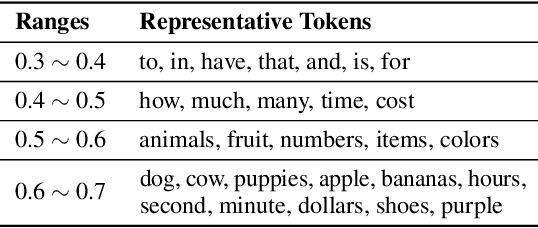


Abstract:Large language models (LLMs) have demonstrated remarkable performance on various tasks. However, it remains an open question whether the default Euclidean space is the most suitable choice for embedding tokens in LLMs. In this study, we first investigate the non-Euclidean characteristics of LLMs. Our findings reveal that token frequency follows a power-law distribution, with high-frequency tokens clustering near the origin and low-frequency tokens positioned farther away. Additionally, token embeddings exhibit a high degree of hyperbolicity, indicating a latent tree-like structure in the embedding space. Building on the observation, we propose to efficiently fine-tune LLMs in hyperbolic space to better exploit the underlying complex structures. However, we found that this fine-tuning in hyperbolic space cannot be achieved with naive application of exponential and logarithmic maps, when the embedding and weight matrices both reside in Euclidean space. To address this technique issue, we introduce a new method called hyperbolic low-rank efficient fine-tuning, HypLoRA, that performs low-rank adaptation directly on the hyperbolic manifold, avoiding the cancellation effect caused by the exponential and logarithmic maps, thus preserving the hyperbolic modeling capabilities. Through extensive experiments, we demonstrate that HypLoRA significantly enhances the performance of LLMs on reasoning tasks, particularly for complex reasoning problems. In particular, HypLoRA improves the performance in the complex AQuA dataset by up to 13.0%, showcasing its effectiveness in handling complex reasoning challenges
Graphusion: Leveraging Large Language Models for Scientific Knowledge Graph Fusion and Construction in NLP Education
Jul 15, 2024



Abstract:Knowledge graphs (KGs) are crucial in the field of artificial intelligence and are widely applied in downstream tasks, such as enhancing Question Answering (QA) systems. The construction of KGs typically requires significant effort from domain experts. Recently, Large Language Models (LLMs) have been used for knowledge graph construction (KGC), however, most existing approaches focus on a local perspective, extracting knowledge triplets from individual sentences or documents. In this work, we introduce Graphusion, a zero-shot KGC framework from free text. The core fusion module provides a global view of triplets, incorporating entity merging, conflict resolution, and novel triplet discovery. We showcase how Graphusion could be applied to the natural language processing (NLP) domain and validate it in the educational scenario. Specifically, we introduce TutorQA, a new expert-verified benchmark for graph reasoning and QA, comprising six tasks and a total of 1,200 QA pairs. Our evaluation demonstrates that Graphusion surpasses supervised baselines by up to 10% in accuracy on link prediction. Additionally, it achieves average scores of 2.92 and 2.37 out of 3 in human evaluations for concept entity extraction and relation recognition, respectively.
DTGB: A Comprehensive Benchmark for Dynamic Text-Attributed Graphs
Jun 17, 2024



Abstract:Dynamic text-attributed graphs (DyTAGs) are prevalent in various real-world scenarios, where each node and edge are associated with text descriptions, and both the graph structure and text descriptions evolve over time. Despite their broad applicability, there is a notable scarcity of benchmark datasets tailored to DyTAGs, which hinders the potential advancement in many research fields. To address this gap, we introduce Dynamic Text-attributed Graph Benchmark (DTGB), a collection of large-scale, time-evolving graphs from diverse domains, with nodes and edges enriched by dynamically changing text attributes and categories. To facilitate the use of DTGB, we design standardized evaluation procedures based on four real-world use cases: future link prediction, destination node retrieval, edge classification, and textual relation generation. These tasks require models to understand both dynamic graph structures and natural language, highlighting the unique challenges posed by DyTAGs. Moreover, we conduct extensive benchmark experiments on DTGB, evaluating 7 popular dynamic graph learning algorithms and their variants of adapting to text attributes with LLM embeddings, along with 6 powerful large language models (LLMs). Our results show the limitations of existing models in handling DyTAGs. Our analysis also demonstrates the utility of DTGB in investigating the incorporation of structural and textual dynamics. The proposed DTGB fosters research on DyTAGs and their broad applications. It offers a comprehensive benchmark for evaluating and advancing models to handle the interplay between dynamic graph structures and natural language. The dataset and source code are available at https://github.com/zjs123/DTGB.
 Add to Chrome
Add to Chrome Add to Firefox
Add to Firefox Add to Edge
Add to Edge